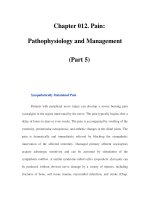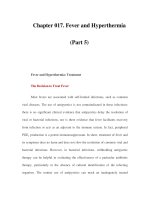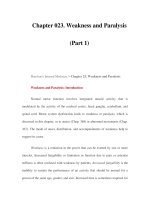Chapter 048. Acidosis and Alkalosis (Part 5) pps
Bạn đang xem bản rút gọn của tài liệu. Xem và tải ngay bản đầy đủ của tài liệu tại đây (82.63 KB, 5 trang )
Chapter 048. Acidosis and
Alkalosis
(Part 5)
Metabolic Acidosis
Metabolic acidosis can occur because of an increase in endogenous acid
production (such as lactate and ketoacids), loss of bicarbonate (as in diarrhea), or
accumulation of endogenous acids (as in renal failure). Metabolic acidosis has
profound effects on the respiratory, cardiac, and nervous systems. The fall in
blood pH is accompanied by a characteristic increase in ventilation, especially the
tidal volume (Kussmaul respiration). Intrinsic cardiac contractility may be
depressed, but inotropic function can be normal because of catecholamine release.
Both peripheral arterial vasodilation and central venoconstriction can be present;
the decrease in central and pulmonary vascular compliance predisposes to
pulmonary edema with even minimal volume overload. Central nervous system
function is depressed, with headache, lethargy, stupor, and, in some cases, even
coma. Glucose intolerance may also occur.
There are two major categories of clinical metabolic acidosis: high-AG and
normal-AG, or hyperchloremic acidosis (Table 48-3 and Table 48-4).
Table 48-4 Causes of High-Anion-Gap Metabolic Acidosis
Lactic acidosis
Toxins
Ketoacidosis Ethylene glycol
Diabetic Methanol
Alcoholic Salicylates
Starvation Propylene glycol
Pyroglutamic acid
Renal failure (acute and chronic)
Metabolic Acidosis: Treatment
Treatment of metabolic acidosis with alkali should be reserved for severe
acidemia except when the patient has no "potential HCO
3
–
" in plasma. Potential
[HCO
3
–
] can be estimated from the increment (∆) in the AG (∆AG = patient's AG
– 10). It must be determined if the acid anion in plasma is metabolizable (i.e., β-
hydroxybutyrate, acetoacetate, and lactate) or nonmetabolizable (anions that
accumulate in chronic renal failure and after toxin ingestion). The latter requires
return of renal function to replenish the [HCO
3
–
] deficit, a slow and often
unpredictable process. Consequently, patients with a normal AG acidosis
(hyperchloremic acidosis), a slightly elevated AG (mixed hyperchloremic and AG
acidosis), or an AG attributable to a nonmetabolizable anion in the face of renal
failure should receive alkali therapy, either PO (NaHCO
3
or Shohl's solution) or
IV (NaHCO
3
), in an amount necessary to slowly increase the plasma [HCO
3
–
] into
the 20–22 mmol/L range.
Controversy exists, however, in regard to the use of alkali in patients with a
pure AG acidosis owing to accumulation of a metabolizable organic acid anion
(ketoacidosis or lactic acidosis). In general, severe acidosis (pH < 7.20) warrants
the IV administration of 50–100 meq of NaHCO
3
, over 30–45 min, during the
initial 1–2 h of therapy. Provision of such modest quantities of alkali in this
situation seems to provide an added measure of safety, but it is essential to
monitor plasma electrolytes during the course of therapy, since the [K
+
] may
decline as pH rises. The goal is to increase the [HCO
3
–
] to 10 meq/L and the pH to
7.15, not to increase these values to normal.
High-Anion-Gap Acidoses
Approach to the Patient: High-Anion-Gap Acidoses
There are four principal causes of a high-AG acidosis: (1) lactic acidosis,
(2) ketoacidosis, (3) ingested toxins, and (4) acute and chronic renal failure (Table
48-4). Initial screening to differentiate the high-AG acidoses should include (1) a
probe of the history for evidence of drug and toxin ingestion and measurement of
arterial blood gas to detect coexistent respiratory alkalosis (salicylates); (2)
determination of whether diabetes mellitus is present (diabetic ketoacidosis); (3) a
search for evidence of alcoholism or increased levels of β-hydroxybutyrate
(alcoholic ketoacidosis); (4) observation for clinical signs of uremia and
determination of the blood urea nitrogen (BUN) and creatinine (uremic acidosis);
(5) inspection of the urine for oxalate crystals (ethylene glycol); and (6)
recognition of the numerous clinical settings in which lactate levels may be
increased (hypotension, shock, cardiac failure, leukemia, cancer, and drug or toxin
ingestion).









